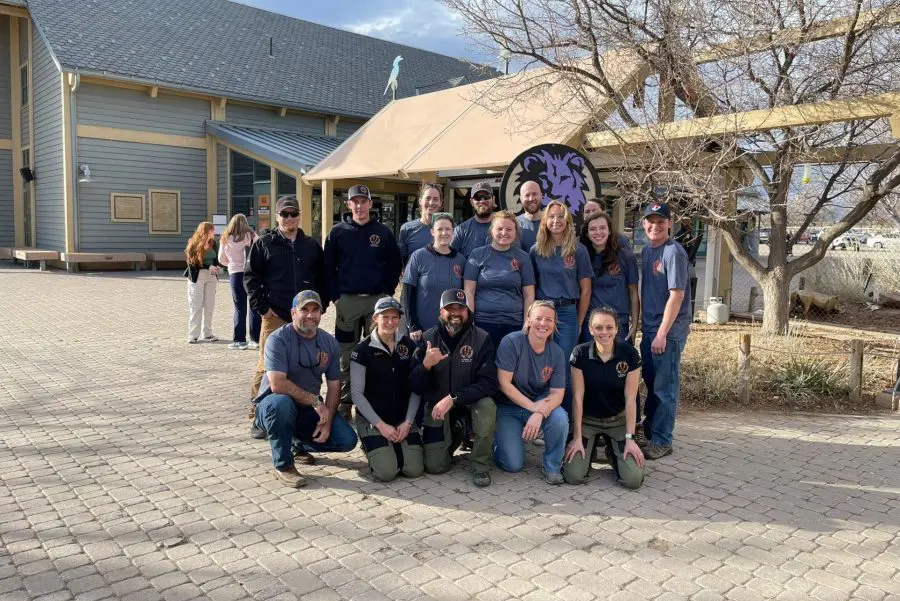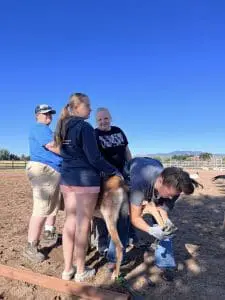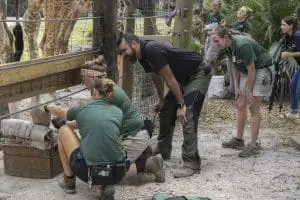

Brevard Zoo Africa keeper Morgan Thums poses with her graduating class at the Zoo Hoofstock Trim Program!
You may have read about all of the training our animal care team does with our animal residents who need their hooves regularly trimmed and shaped like our giraffes, Grevy’s zebra and Eastern bongo. We aim to give our animal residents meaningful choice and control in all they do, so it’s important to our animal care team to empower everyone from Grevy’s zebra Iggy to giraffe Milenna to voluntarily participate in their hoof trim.
But who trains the trainers?
We’ve sent several members of our animal care team to the Zoo Hoofstock Trim Program, an intensive 7-day course that covers hoof anatomy, common hoof pathologies, and more. For this blog, we asked two of our Africa keepers and recent students of this course, Morgan Thums and Savannah Luhn, to share a bit more about what the week entails! Read on to learn more.
What made you want to take this course?
Morgan: Ever since I started a the zoo I really enjoyed training our animals for trims. The longer I was at the zoo the more I wanted to learn about the whole process. Going to the course was the next step.
Savannah: I have always had an interest in hoof care and trimming. It started way back when I was younger and worked with horses. However, more recently, it started with hoof trimming on our goats. When I moved to Africa, our hoof stock dominated area, it was a no brainer that I wanted to attend this course and continue to learn!
 Can you tell us about what you did throughout the week?
Can you tell us about what you did throughout the week?
Morgan: It is a jam-packed week of information. The first few days were mostly lectures on anatomy and grade a hoof. We did lots of trimming on cadavers both equine and two toed. We visited the local zoo and watched training and trimming. The last day we were also able to trim some live animals.
Savannah: We did a lot of lectures – there was lots of information to get before we were ready to trim. We did lots of anatomy and background. We were able to dissect a horse and bovine foot to better understand the anatomy. We trimmed on lots of cadaver hooves first, that way we were able to practice mapping, tool usage, and get a feel for what it was like. On the last day, we trimmed live goats and sheep!
How would you describe this experience to someone new to hoof trims?
Morgan: Honestly, an overload of information but in a great way! You wake up and just learn about trimming until you go to sleep again that day. I even dreamed about hooves! It is a great experience that helps you learn so much information in a short period of time.
 How has this course benefited you? How has it benefited your animal residents?
How has this course benefited you? How has it benefited your animal residents?
Morgan: I learned more information than I thought I could about trimming and the importance of trimming than I thought I ever would. I went to the course back in February and I have already been able to solo trim almost all of the animals we trim at the zoo. Being able to be one of the many trimmers we have here at the zoo really helps us to stay on top of trimmers and make sure that all of your animals receive routine trims when they need them.
Savannah: This course served a huge learning opportunity to me! As someone who has been in the field for 3 years now, it is important to me that I continue to learn and grow my skills. Through this experience, I can continue to develop my own skills while improving our animals’ lives. By sending more keepers through this training, our team is better able to keep up with routine trimming, as well as work on trimming with different species of Hoof stock.
What was the most surprising thing you learned?
Morgan: I think for me personally it is just how much information I was able to learn and be able to retain in such a short time. Also just how important maintaining our animals hooves can impact their comfortability and add years to their life that they might not have had without getting proper hoof care.
Savannah: I think the overarching most surprising thing would be just how much goes into the lower limb/hoof! There are so many parts that play a huge role in the animal’s ability to walk. It is something we don’t think a lot about unless specifically learning anatomy or having an animal walk abnormally.
Brevard Zoo is an independent, not-for-profit organization that receives no recurring government funding for our operating costs. Your generous support enables us to continue to serve our community and continue our vital animal wellness, education and conservation programs.